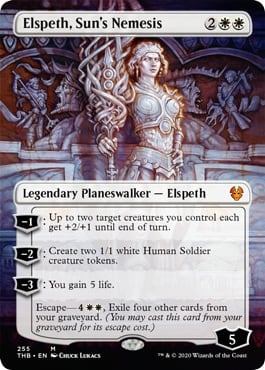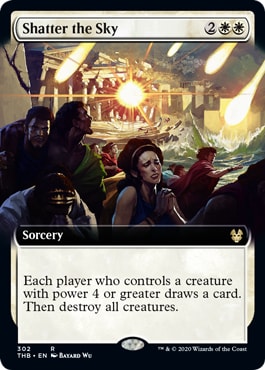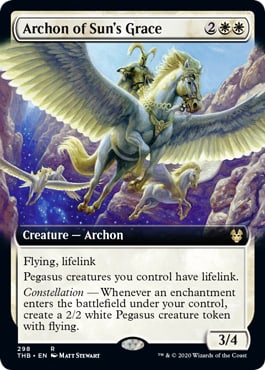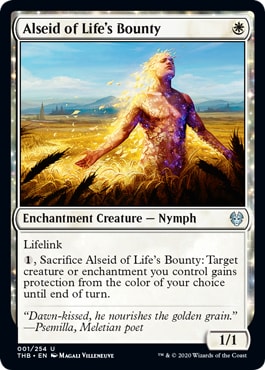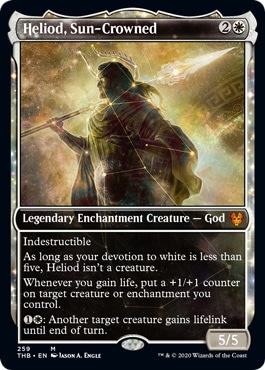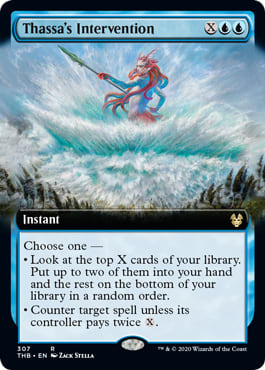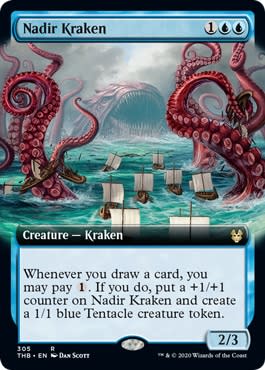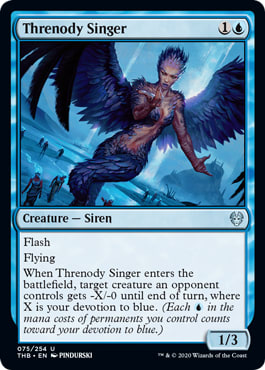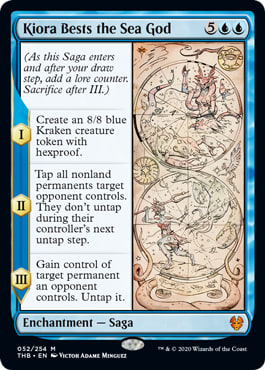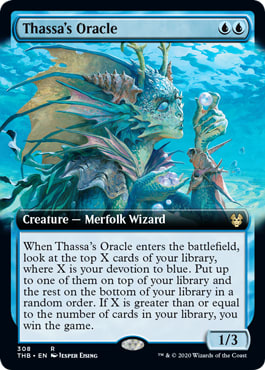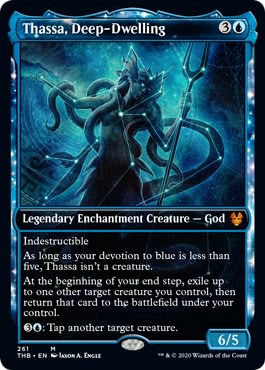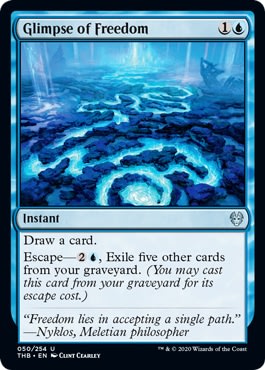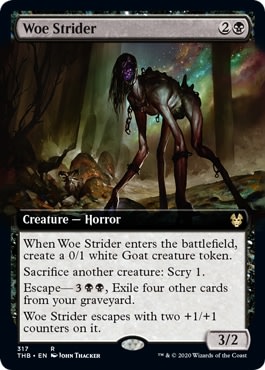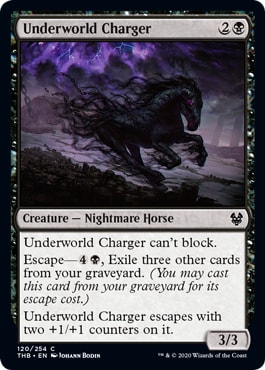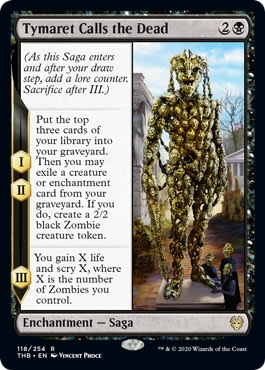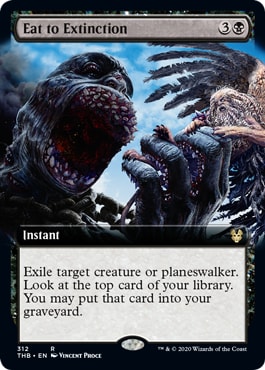Ikoria: Lair of the Behemoths is around the corner and Theros Beyond Death has several good cards for Cube. Since we're quarantined in for the near future, it's safe to say that our collective Cube time will be drastically shortened for the time being, and since this set is a pumping on the brakes (compared to Throne of Eldraine), it's a good time to reflect on what we have in our Cubes.
As usual, these evaluations are based on actual Cube experience from several Cube drafts in various Cubes, referenced in this article, and discussion from other Cube drafter's experiences on the MTG Cube Brainstorming discord. I've always worked to have cards go through the ringer with many Cube reps before posting my reviews, and even though the holidays and Covid-19 messed with testing data, these every deck listed in this article contained Theros Beyond Death cards and either went 3-0 or had the best record in their respective Cube drafts.
Of course, going 3-0 with a card in a deck isn't ironclad proof of that card being good, but it does help illustrate how the card performs in actual Cube decks. Cards are sorted in order of approximate interest by color - the ones that pique my interest for Cube discussed first in approximate order. If a card isn't discussed here, it's intentional (because it compares poorly to other options/very obviously isn't good). I've always tried to make sure my Cube reviews use a pretty "generalist" point-of-view, so season to taste if you feel like cards may fare better/worse in your Cube and your Cube's metagame.
Skip to
White
Elspeth, Sun's Nemesis - in my Throne of Eldraine review, I briefly talked about how Elspeth, Sun's Nemesis was underrated based on experience from when she was leaked. Meme deity Zolthux posted a poll which showed, if anything, a majority of the players had 0 reps with her.

It should go without saying Elspeth, Sun's Nemesis is several leagues better than her Planeswalker Deck iteration, and despite the 4-drop slot in White being crowded, she punched well above that weight class. Generally, like with most 4+ card escape costs, I found Elspeth tended to escape about once, occasionally twice in the average Cube game. I'm unsure how well she's been received in the weeks after her release since she's less a planeswalker and more a History of Benalia, which generally plays like this:
Chapter 1 & 2: make 2 1/1 White Human Soldier tokens.
Chapter 3: Give up to two of your creatures +2/+1 until end of turn.
She's been a welcome addition to White cube decks as a resilient damage source, although her boosting ability/lifegain modes were less useful for control and aggro decks, respectively. Coming back from the graveyard meant she almost always threatened to come back, so sending her to the grave was usually a bad use of resources. She tended to see more play in aggro, in decks like this:
Test Deck #1 | Cube| Usman Jamil
- Creatures (16)
- 1 Bomat Courier
- 1 Dryad Militant
- 1 Flickerwisp
- 1 Icehide Golem
- 1 Inquisitor Exarch
- 1 Kytheon, Hero of Akros
- 1 Law-Rune Enforcer
- 1 Mother of Runes
- 1 Restoration Angel
- 1 Rhys the Redeemed
- 1 Scrapheap Scrounger
- 1 Selfless Spirit
- 1 Shepherd of the Flock
- 1 Stoneforge Mystic
- 1 Thalia, Guardian of Thraben
- 1 Walking Ballista
- Planeswalkers (4)
- 1 Elspeth, Sun's Nemesis
- 1 Gideon of the Trials
- 1 Gideon, Ally of Zendikar
- 1 Serra the Benevolent
- Instants (2)
- 1 Mana Tithe
- 1 Secure the Wastes
- Sorceries (1)
- 1 Finale of Glory
- Artifacts (1)
- 1 Sword of Truth and Justice
- Lands (16)
- 9 Snow-Covered Plains
- 1 Badlands
- 1 Blinkmoth Nexus
- 1 Flooded Strand
- 1 Plateau
- 1 Rishadan Port
- 1 Scalding Tarn
- 1 Silent Clearing
And even in a deck type that normally doesn't want lifegain, having the ability as an option was nice. However, she's been no stranger to slower White decks, like this:
Test Deck #2 | Cube | Usman Jamil
- Creatures (12)
- 1 Adanto Vanguard
- 1 Bomat Courier
- 1 Cenn's Tactician
- 1 Figure of Destiny
- 1 Frontier Explorer
- 1 Hangarback Walker
- 1 Inquisitor Exarch
- 1 Mikaeus, the Lunarch
- 1 Phyrexian Revoker
- 1 Stonecoil Serpent
- 1 Thraben Inspector
- 1 Vendilion Clique
- Planeswalkers (3)
- 1 Elspeth, Sun's Nemesis
- 1 Gideon of the Trials
- 1 Gideon, Ally of Zendikar
- Instants (6)
- 1 Dig Through Time
- 1 Force Spike
- 1 Mana Leak
- 1 Path to Exile
- 1 Swords to Plowshares
- 1 Thassa's Intervention
- Sorceries (2)
- 1 Council's Judgment
- 1 Preordain
- Enchantments (1)
- 1 Omen of the Sea
- Artifacts (1)
- 1 Heirloom Blade
- Lands (15)
- 6 Snow-Covered Island
- 7 Snow-Covered Plains
- 1 Hallowed Fountain
- 1 Misty Rainforest
She's been a very welcome addition to White decks of all kinds in Cube. If you're concerned about 4-drop saturation, don't be afraid to cut something at another mana cost when including this (as you should be doing in general.)
Shatter the Sky - While creatures have gotten significantly better in the decade that I've been designing Cubes, mass removal has, for the most part, stayed the same with "Small wraths" like Pyroclasm, Whipflare, Rough // Tumble, and Drown in Sorrow, newly printed unconditional wraths generally being 5+ mana for (Realm-Cloaked Giant), and four mana being reserved for wraths with conditions or drawbacks, like Languish.
Realm-Cloaked Giant was a step in the right direction for a wrath that costs over four mana, but generally the mantra of cheaper being better applies for wraths as well. Wraths are at their best against aggro decks, and one turn can mean the difference between dying and not dying.
So how has Shatter the Sky been? Generally, decks that are in the market for a Wrath type effect like Shatter the Sky aren't packing a lot of creatures, and if those decks have a 4+ power creature out, it's being deployed to kill the opponent once the game is stabilized and only occasionally as a blocker. This meant that the card draw was generally irrelevant against aggro and a drawback against midrange (where control is generally favored). That said, it's been nice as a function to do what wraths have done since the beginning of time - stabilize, punish overextension, and, to quote the flavor text on Wall of Denial, buy a discerning mage some time. Inclusion in your Cube may depend on your White section's goals, but it's ultimately better for control decks than something like a Sun Titan.
Eidolon of Obstruction - In the early days of Cube, supporting White aggro meant using cards like Knight of Meadowgrain, Soltari Monk/Priest, Knight of the White Orchid, and Eight-and-a-Half Tails, making those decks need to either be mono/mostly White or risk stumbling on their mana, resulting in threats not being deployed on time and losing. As creatures got better, we've gotten better ![]()
![]() cards like Stoneforge Mystic, Thalia, Guardian of Thraben, Adanto Vanguard, Shepherd of the Flock, and Ancestral Blade to take some of the weight off of needing to hit
cards like Stoneforge Mystic, Thalia, Guardian of Thraben, Adanto Vanguard, Shepherd of the Flock, and Ancestral Blade to take some of the weight off of needing to hit ![]()
![]() on turn two and resulting in cards like Silver Knight being a relic of Cube's past, even in peasant C ube.
on turn two and resulting in cards like Silver Knight being a relic of Cube's past, even in peasant C ube.
The "death and taxes" style of disruption isn't usually the kind of tactical nuke that leaves the opponent helpless with a single card, but Death by A Thousand Cuts with cards that disrupt the opponent *just* enough to put off their tempo can lead them to lose by not being able to enact their overall gameplan in time.
Planeswalkers, by their very nature, work on a principle of high mana investment for a consistent return over time, rather than a one-shot effect like (most) single spells. We include these in our Cubes because we expect to have Jace, the Mind Sculptor out over several turns to spam Brainstorms and for Gideon, Ally of Zendikar to spam out 2/2s. We assume we'll live long enough to pay that high ![]()
![]()
![]() or
or ![]()
![]()
![]() mana cost and get our pay off. In warped Cube metas where aggressive decks are lagging, this is even more true, to the point where Planeswalkers are blamed for making aggro bad (I'll go more into depth on this in a future article which, at this pace, will be written in 2025.) Paying the high mana cost upfront meant that it wasn't that awful of a deal to pay the
mana cost and get our pay off. In warped Cube metas where aggressive decks are lagging, this is even more true, to the point where Planeswalkers are blamed for making aggro bad (I'll go more into depth on this in a future article which, at this pace, will be written in 2025.) Paying the high mana cost upfront meant that it wasn't that awful of a deal to pay the ![]() to activate planeswalkers, but it could be depending on the deck (if it had thin mana margins) or the board state. Generally, it was still right to pay a mana to Brainstorm, invite the opponent's creatures to a party at Gideon Jura's, etc.
to activate planeswalkers, but it could be depending on the deck (if it had thin mana margins) or the board state. Generally, it was still right to pay a mana to Brainstorm, invite the opponent's creatures to a party at Gideon Jura's, etc.
Eidolon's statline is *fine* by 2020 creature standards, like Thalia, Guardian of Thraben. The floor is similarly high for it, and higher than Shepherd of the Flock when it's hosing planeswalkers. Generally, even in my own Cube where I don't shy away from including planeswalkers, it was rare for Eidolon to hose two planeswalkers at the same time. It was fine as a small creature that carried pants well and attacked into similarly sized creatures well. This aggressive midrange deck had it and it was pretty good at being a 2/1 with first strike, for a more atypical use of Eidolon:
Test Deck #3 | Cube | Usman Jamil
- Creatures (16)
- 1 Biogenic Ooze
- 1 Courser of Kruphix
- 1 Dryad Militant
- 1 Dryad of the Ilysian Grove
- 1 Eidolon of Obstruction
- 1 Frontier Explorer
- 1 Knight of Autumn
- 1 Kytheon, Hero of Akros
- 1 Nightpack Ambusher
- 1 Questing Beast
- 1 Rhys the Redeemed
- 1 Rofellos, Llanowar Emissary
- 1 Scavenging Ooze
- 1 Stoneforge Mystic
- 1 Tireless Tracker
- 1 Wolfir Avenger
- Sorceries (1)
- 1 Lingering Souls
- Enchantments (3)
- 1 Legion's Landing
- 1 Sylvan Library
- 1 The First Iroan Games
- Artifacts (4)
- 1 Batterskull
- 1 Bonesplitter
- 1 Grafted Wargear
- 1 Selesnya Signet
- Lands (16)
- 6 Snow-Covered Plains
- 8 Snow-Covered Forest
- 1 Karakas
- 1 Silent Clearing
Its impact may have been from not seeing it in decks with cards like Vryn Wingmare, Knight of the Holy Nimbus, Leonin Relic-Warder, and Ethersworn Canonist. As noted before, these kinds of taxing effects are much better when compounded, rather than just as a single sting; but, even if it's not working with other taxers, I found it to be pretty solid.
Archon of Sun's Grace mostly played as a smaller Baneslayer/Gisela, the Broken Blade - a midsized flier with lifelink that lined up poorly against non-Red removal.
The elephant in the room is whether this and other enchantment cards provide the tipping point to make "enchantress" decks a thing in Cube. Over the years, I've seen these kinds of "tipping point" discussions crop up, like "is it finally time to retire Savannah Lions from Cube" or "is there enough support to make Elf tribal a deck", typically from the introduction of a single card. There are several cards with Constellation in the set but for the most part, the talking points to including it are similar.
Whenever I see enchantress themes in Cube, they generally play out as poor versions of midrange, where the stars align if given time, coming at the cost of including parasitic cards like Doomwake Giant, City of Solitude, and Eidolon of Blossoms that only one specific deck wants - enchantment-based midrange. Inherently parasitic cards, like in the Splinter Twin combo (Pestermite/Deceiver Exarch/Great Oak Guardian/Splinter Twin), can manifest as a subset of a generic archetype like midrange or control (not aggro). Usually, a deck with Doomwake Giant or Eidolon of Blossoms wants as many enchantments as possible, or finds itself riding the sideboard pine due to not having enough impact in the deck without a critical mass of enchantments.
When I have new drafters draft my Cube, I've seen some ask if, because I run Utopia Sprawl, Wild Growth, Fertile Ground, and Abundant Growth, if there's an enchantment theme, but much like how Gemhide Sliver in a Pauper Cube doesn't point to a Sliver theme, nor should those land auras point to an enchantment theme.
Archon of Sun's Grace is an example of what could be a good card of this type - as a card that is a threat on its own, but myself and others have found ourselves falling less in love with these types of finishers due to how poorly they line up against non-Red removal and how polar they are against Red. If you're ok with one of those types of finishers, it may be worth using as a small Baneslayer Angel with some potential upside, but don't go into it expecting to drive an enchantment theme into your Cube.
If you've followed my content, you've likely seen me harp on about Heirloom Blade, a card that completely flew under the radar as it was assumed to just be a cute tribal card, as I looked at previous 3-0 decks and saw how it could work well in them, and from testing then onward, it's been a great addition to my Cube. It's not a perfect way to find out if a card works in a typical Cube deck, but it's a nice tool to find approximations.
Because of this, I looked at other well-performing White decks to see how often the enchantment payoff would occur to see if this could organically work in good White cube decks (from Cube data), with generically good enchantments, like the Green land auras and cards like Oblivion Ring and its various analogues. Unfortunately, this reality didn't pan out due to the parasitic nature of cards that care about enchantments.
Taranika, Akroan Veteran - When I tried Taranika out, I wasn't that impressed by her - if she's active, she can act like a budget Geist of St. Traft but she wasn't that great if she didn't have something to boost, acting closer to a piece of equipment that could die to creature removal. She played best in aggressive White decks to turn smaller creatures into 4/4s, but overall, I just found things like Heirloom Blade, Grafted Wargear, and Ajani, Caller of the Pride to be better uses of three mana in aggro decks.
Alseid of Life's Bounty - When compared to cards like Benevolent Bodyguard, the cost of activation of 1 is a chasm's width away from a free mana activation, more so for a deck as mana-tight as aggro. Despite being better as a french vanilla 1/1 as opposed to a plain vanilla 1/1, it wasn't high-impact enough as a 1/1 for midrange decks and other more efficient and impacting 1-drops were better in aggro.
In the Throne of Eldraine review, I referenced Pixel's article about using hypermetric geos for finding how many 1-drops you want in your aggro deck to make sure that those decks have at least one in hand (which is more than you'd think), but even with that consideration, there's better options out there.
Heliod, Sun-Crowned - Despite the printing of some cards like Benalish Marshal, this new guard of Theros gods become creatures about as often as the old ones - hardly at all. This is one of the more overrated cards for Cube in the set, likely because it interacts so well with Walking Ballista. Unfortunately, it fares poorly when it isn't combined with that, essentially requiring a ![]()
![]() payment to give a creature lifelink and a +1/+1 counter for its next combat. As noted above, that kind of mana tax is prohibitively high in aggro and a bit too do-nothing in decks like midrange.
payment to give a creature lifelink and a +1/+1 counter for its next combat. As noted above, that kind of mana tax is prohibitively high in aggro and a bit too do-nothing in decks like midrange.
Heliod's Punishment - Two-mana removal is generally fine for decks of all stripes, although being sorcery speed and having the ability to be eventually negated is a big sticking point against this. It's worse than the Journey to Nowheres, Temporal Isolations, Pacifisms, and Spectral Grasps of the world. If you need another, here you go.
Heliod's Intervention does poorly in terms of base function, and even with a bunch of artifacts out, it's still an incredibly narrow hoser for artifact decks and aggro. It's poor on-rate for mana efficiency. Include if you feel like you need a hoser for those kinds of strategies, but as a generalist card it's inefficient.
Blue
Omen of the Sea - Another card that was shown in the early leaks for Theros Beyond Death, and it's always been impressive. I've been digging the championing of cantrips from the MTG Brainstorming Discord, and this is another card that works exceptionally well in Blue decks. On top of being card draw + card selection, it represents multiple turns of holding up mana a la Think Twice; while it didn't happen as often as I thought, being able to represent potential countermagic with a backup of scrying for 2 was a great tool for reactive Blue decks.
Like Thassa's Intervention, it's been a great tool to make Blue decks flow more consistently, and I've been a big fan of how it's been playing. In a color as stacked as Blue, bread-and-butter effects like cantrips with library manipulation are easy to dismiss, but they're vitally important to in those decks. If you feel like you don't have room for this, cut something like Fact or Fiction for Omen of the Sea; as weird as it may sound, you'll be glad you did and you'll be impressed.
Thassa's Intervention scales incredibly well as a riff on Supreme Will (an analogy made by SirFunchalot). In recent years, we've seen a lot of these kinds of cards make impacts in Cube - Voracious Hydra, Rimrock Knight, etc etc, where the "base mode" of a weird version of Convolute/expensive cantrip is still generally fine when the situation calls for it, but it's generally intended to cost ![]()
![]()
![]() and above. It's been incredibly flexible and a solid add.
and above. It's been incredibly flexible and a solid add.
I managed to go 3-0 with this in Sirfunchalot's cube:
Test Deck #4 | Cube | Sirfunchalot
- Creatures (2)
- 1 Gadwick, the Wizened
- 1 Hypnotic Sprite
- Planeswalkers (4)
- 1 Daretti, Ingenious Iconoclast
- 1 Jace, Architect of Thought
- 1 Oko, Thief of Crowns
- 1 Teferi, Hero of Dominaria
- Instants (14)
- 1 Brainstorm
- 1 Censor
- 1 Fatal Push
- 1 Fire // Ice
- 1 Hieroglyphic Illumination
- 1 Mana Leak
- 1 Opt
- 1 Quench
- 1 Rune Snag
- 1 Telling Time
- 1 Terror
- 1 Thassa's Intervention
- 1 Truth or Tale
- 1 Worldly Counsel
- Sorceries (5)
- 1 Discovery // Dispersal
- 1 Ponder
- 1 Scour All Possibilities
- 1 Serum Visions
- 1 Toxic Deluge
I generally didn't see it cast for ![]()
![]()
![]() to be a bad Complicate/cantrip, but was nice in the emergency scenarios when needed, like casting Hydroid Krasis for X = 1 or 2.
to be a bad Complicate/cantrip, but was nice in the emergency scenarios when needed, like casting Hydroid Krasis for X = 1 or 2.
I've found it significantly better than something like Cryptic Command and much more flexible. It's easy to look at something like this and dismiss it as a bad Inspiration, but something that was really drilled home in Throne of Eldraine was not only how good flexible cards were (that had a good base rate) but also that performed a base *function* of a deck well.
Cards like Liliana, the Last Hope are never put into a deck with the hope of making a bunch of zombies, but more with the hope of killing small things and maybe bringing creatures back as the base function. I never saw Thassa's Intervention act as a full Dig Through Time but usually it was cast to great effect for 5-6 mana if need be. I've talked before in previous articles about how Cube decks don't really need a lot of high-cost draw effects, and this isn't one either - but it can be if there's nothing else to do. Overall, I've found this to be an impressive card for all kinds of Blue cube decks.
Nadir Kraken - In the part about Alseid of Life's Bounty, I talked about how a 1 mana cost is astronomically higher than 0 in aggro as the archetype typically wants to use all of its mana every turn, whereas control decks aren't as constrained by that as part of their gameplan.
Nadir Kraken has performed well as it quickly gets out of hand by going tall *and* wide by providing essentially a 2/2's worth of stats for a single mana. The floor as a Blind Phantasm is fine as is as a blocker, but since it only needs to survive for a draw step, I found that it almost always got value and took only a few turns before it was able to gum up the floor and turn the corner with minimal effort, even when relying on just the draw step. Anecdotally, I've already seen it paired with Jace, the Mind Sculptor as a turbo-tentacle engine, but even with your bog standard cantrips, it's been a great addition to blue decks.
Even in lower-to-the-ground Blue decks, it worked well, like in this deck:
Test Deck #5 | Cube | Usman Jamil
- Creatures (16)
- 1 Bloodsoaked Champion
- 1 Burning-Tree Emissary
- 1 Glorybringer
- 1 Goblin Guide
- 1 Grenzo, Havoc Raiser
- 1 Monastery Swiftspear
- 1 Nadir Kraken
- 1 Pestermite
- 1 Rhys the Redeemed
- 1 Seasoned Pyromancer
- 1 Shepherd of the Flock
- 1 Snapcaster Mage
- 1 Thraben Inspector
- 1 Venser, Shaper Savant
- 1 Whirler Rogue
- 1 Zurgo Bellstriker
- Planeswalkers (1)
- 1 Serra the Benevolent
- Instants (5)
- 1 Daze
- 1 Dig Through Time
- 1 Force Spike
- 1 Secure the Wastes
- 1 Swords to Plowshares
- Sorceries (3)
- 1 Fiery Confluence
- 1 Unearth
- 1 Winds of Abandon
Even though the 1/1 tentacles look middling, they work well with Blue's game plan of stalling, keeping you alive and eventually letting you win. The kraken can't protect itself, but it doesn't take long for it to be big enough to eat just about anything blocking it. While tapping out on turn three was usually wrong, its cheap cost made it so that it was easy to deploy with countermagic backup or as an emergency blocker. While Blue doesn't lean as hard into its finishers as they're mostly replaceable, Nadir Kraken is a great addition to the team.
Alirios, Enraptured was a pile of value that played somewhat similarly to Blade Splicer, and was annoying to play against from the aggro deck's point of view (although it would have been more so if the Illusion and Alirios's stats were swapped). Its small body tended to suffer against midrange, and as such, was usually sided out in subsequent games in that matchup. Depending on the matchup, I found it to be fine to tap out for on turn three and was better than its middling appearance may imply.
Thryx, the Sudden Storm played, for the most part, like a very large Ambush Viper/Torrential Gearhulk (with nothing to flash back) with its trinket text being mostly irrelevant. Flash creatures tend to play well in Blue decks by being able to allow you to deploy threats without having to commit to doing so on your own main phase, and predictably played as well as I'd expected - better than 6-mana main phase threats like Frost Titan and Will Kenrith but unnecessary in Cubes where other cards support Blue control better (planeswalkers, cheap cantrips and counters, etc). Still, in times when drafters saw it in packs and the players were in the archetype, it was played. Like many big splashy things, not as "necessary" as it may seem for Cubes.
Threnody Singer wasn't bad as a combat trick that could randomly eat Savannah Lions but it was limited mostly to that role - for helping control's matchup against aggro. Flash cards tend to play better than they look. The dream scenarios of it causing combat blowouts didn't happen often, and it was generally a filler card, one whose slot is better suited to a cantrip like the underrated Truth or Tale, Think Twice, or Telling Time.
Kiora Bests the Sea God ended up being a big clunky finisher in a color with much better and more efficient options that go along with Blue's gameplan - even something like the (underrated) Unesh, Criosphinx Sovereign works better toward the big Blue control plan. While nearly unbeatable in retail Limited, it's just too slow for its cost in Cube.
Thassa's Oracle - Due to the alternate victory text, it's easy to compare it to Laboratory Maniac,. but I found that it compared much closer to Omenspeaker at the role of card selection - think how often the original Theros gods were creatures (not very often.) As noted earlier, the role is better filled by something like Truth or Tale or Omenspeaker unless you're utilizing it as a tool like Ryan Saxe's cube as a wincon a la Nexus of Fate. For those who aren't, I wasn't impressed.
Thassa, Deep Dwelling - Much like Archon of Sun's Grace, you'll know if you're in the market for this as a blink tool and I won't really convince anyone otherwise since it plays about as expected. A blink enabler but a poor use of mana otherwise. Include according to your Blue decks' goals.
Glimpse of Freedom - Despite loving escape cards, I've not been that impressed with this. It usually ended up being a Think Twice that required a ton of other cards in the graveyard to flash back, and almost never escaped twice. Sadly, a poor performer.
Callaphe, Beloved of the Sea didn't do enough for its cost as a bad Kira, Great Glass-Spinner and Thirst for Meaning and Elite Instructor were mostly fine as reanimator enablers to dump large bodies into the graveyard; cards that have much better analogues but may be something worth looking into if you've exhausted options like Frantic Search, Thirst for Knowledge, and the other usual suspects.
Black
Aphemia, the Cacophony - If you've read my reviews before, you'll recall Mark Rosewater bringing up additive distraction and how that tends to plague card evaluation. As a refresher:
Bear on Steroids
![]()
![]()
Creature - Bear
3/4
If I showed that around, I'd probably get pretty good responses. We've only done one card with the same cost and stats before (Plant Elemental
from Portal) and it required you to sacrifice a Forest. Now imagine I tweak the card:
Geeky Bear on Steroids
![]()
![]()
Creature - Bear
If you control at least ten artifacts, CARDNAME gains trample.
�
If I show this card around, I'm going to get a lot fewer positive responses. People will focus on the condition about ten artifacts, and many will come to the conclusion that there isn't really a deck for this card.
But here's the thing: players were excited by the card without the extra line of text. Geeky Bear on Steroids is by every definition of the term "strictly better" than Bear on Steroids from a power standpoint. It has a conditional upside. It's just as good as the original and, in a very narrow case, can be even better.
My point is that how players perceive cards is very connected to how they process what's on it. Having the word "teammate" on cards was throwing people because it made them evaluate the card in terms of whether or not they might play a format where having a teammate mattered."
The weird ability to make zombies is this card's additive distraction, as it's mostly just an aggressive 2/1 flier for ![]()
![]() that doesn't have a drawback. Every once in a while the stars will align for it to make a zombie, but from what I've seen, it doesn't happen often and that's fine. This isn't a card like Doomwake Giant that requires an enchantment theme, but it is a welcome addition if you can turn a Gnarled Scarhide into a zombie. Buildingadeck and Sirfunchalot have utilized these fliers in their Cubes to help aggressive decks get over large ground blockers, and this is one of the better tools for that.
that doesn't have a drawback. Every once in a while the stars will align for it to make a zombie, but from what I've seen, it doesn't happen often and that's fine. This isn't a card like Doomwake Giant that requires an enchantment theme, but it is a welcome addition if you can turn a Gnarled Scarhide into a zombie. Buildingadeck and Sirfunchalot have utilized these fliers in their Cubes to help aggressive decks get over large ground blockers, and this is one of the better tools for that.
Agonizing Remorse - While premium 1-mana discard like Inquisition of Kozilek, Duress, and Thoughtseize are the cream of the crop, I've come to appreciate 2-mana discard from trying the Mesmeric Fiend/Brain Maggot/Kitesail Freebooter trio and cards like Transgress the Mind and Lose Hope from their use in Discord Cubes. Unlike the aforementioned 1-mana trio, where it was usually wrong to put any of them in the sideboard, generally the ones attached to bodies were best in aggro, since they were able to utilize the bodies as a clock, whereas slower Black decks best utilized cards like Transgress the Mind. Being similar to Transgress the Mind, and much like how Law-Rune Enforcer and Giant Killer may have introduced you to the power of tappers, so should this for 2-mana discard.
Woe Strider was another card that had a decent amount of value for the cost - although one where my opinion of it dipped over time. It may have been because of the relatively low use that a Black aggro deck had for the goat and midrange + control having for a Gorilla Warrior. I still thought it was overall fine in decks that aren't sacrifice centric (although it certainly gets better in Cubes that do, obviously.) The ![]()
![]()
![]() cost to escape was also high for aggro decks that couldn't rely on it winning the game right then, but it was a nice backup if flooded.
cost to escape was also high for aggro decks that couldn't rely on it winning the game right then, but it was a nice backup if flooded.
Underworld Charger played similarly, as a worse bargain bin version that goes in the same deck, for the most part. Overall, they were pretty solid but hardly necessary.
Nightmare Shepherd generally played as either a top-end card in aggressive decks, or as a way to squeeze extra value out of Mulldrifter-style creatures that had value outside of their bodies. This deck from Fleish_dawg's cube is a good example of the former deck type, that also included Woe Strider without requiring an "aristocrats" theme.
Test Deck #6 | Cube | Fleish dawg
- Creatures (16)
- 1 Adanto Vanguard
- 1 Dark Confidant
- 1 Giant Killer
- 1 Frogkin Kidnapper
- 1 Gingerbrute
- 1 Icehide Golem
- 1 Kinjalli's Sunwing
- 1 Knight of the Ebon Legion
- 1 Mother of Runes
- 1 Nightmare Shepherd
- 1 Obzedat, Ghost Council
- 1 Order of Midnight
- 1 Ruin Raider
- 1 Skinrender
- 1 Thraben Inspector
- 1 Woe Strider
- Planeswalkers (2)
- 1 Ajani, Adversary of Tyrants
- 1 Liliana, the Last Hope
- Instants (2)
- 1 Evil Boros Charm
- 1 Go for the Throat
- Sorceries (2)
- 1 Inquisition of Kozilek
- 1 Transgress the Mind
- Enchantments (1)
- 1 On Thin Ice
- Artifacts (1)
- 1 Smuggler's Copter
In terms of Black top end for aggro decks, I've liked it significantly more than the old guard of Desecration Demon, Braids, Cabal Minion, Smokestack and others. Much like Anax, it's nice to provide some resilience to your cheap creatures for chump attacking while having a decent body. I've shied away from including these kinds of top-end cards for aggro decks since they can make more use out of lower drops as part of their game plan, but you could certainly do much worse than this as one.
Erebos, Bleak-Hearted - much like with Thassa, you'll know if you're in the market for this as a sacrifice engine, as it's pretty weak outside of that dedicated role.
Mire Triton - Filler for dumping things in the grave for reanimator.
Elspeth's Nightmare, Tymaret Calls the Dead, and Eat to Extinction are too costly compared to the competition, even if going very deep.
As most people reading this are (I assume) cube designers, our cubes may be even more important as something that we can control in a time when things are dreadful and out of our control from Covid19. For many, opening a cube pack is the equivalent of breaking bread as an introduction to a world that you've carefully created; in the coming months, we're not going to be able to break bread as often as we're used to, for a format that's social by its very nature. For us cube designers, this period of social isolation may deprive us of the joys that we'd normally bring to drafters, even if just for a few hours.
But this period is only temporary; as cube designers, we're in it for the long-haul, and although life may fundamentally change after all of this, we will persevere. Please stay at home during this crisis - whether it's for cube data or the experience of cubing in person, you can wait.
I hope that this article has, if anything, provided some joy to you in a world where Covid19 makes it hard to find joy. Be excellent to each other in these dark times.
And be sure to come back tomorrow for the second half of my review!
Blog, featuring my Pauper, Peasant and recently unpowered Cube list. (online list hasn't been updated to reflect this.)
The Third Power, a nearly decade-long running podcast that Anthony Avitollo and I host.
Find me on Twitter @Usmantherad. Check out these discords for Cube discussion!
















